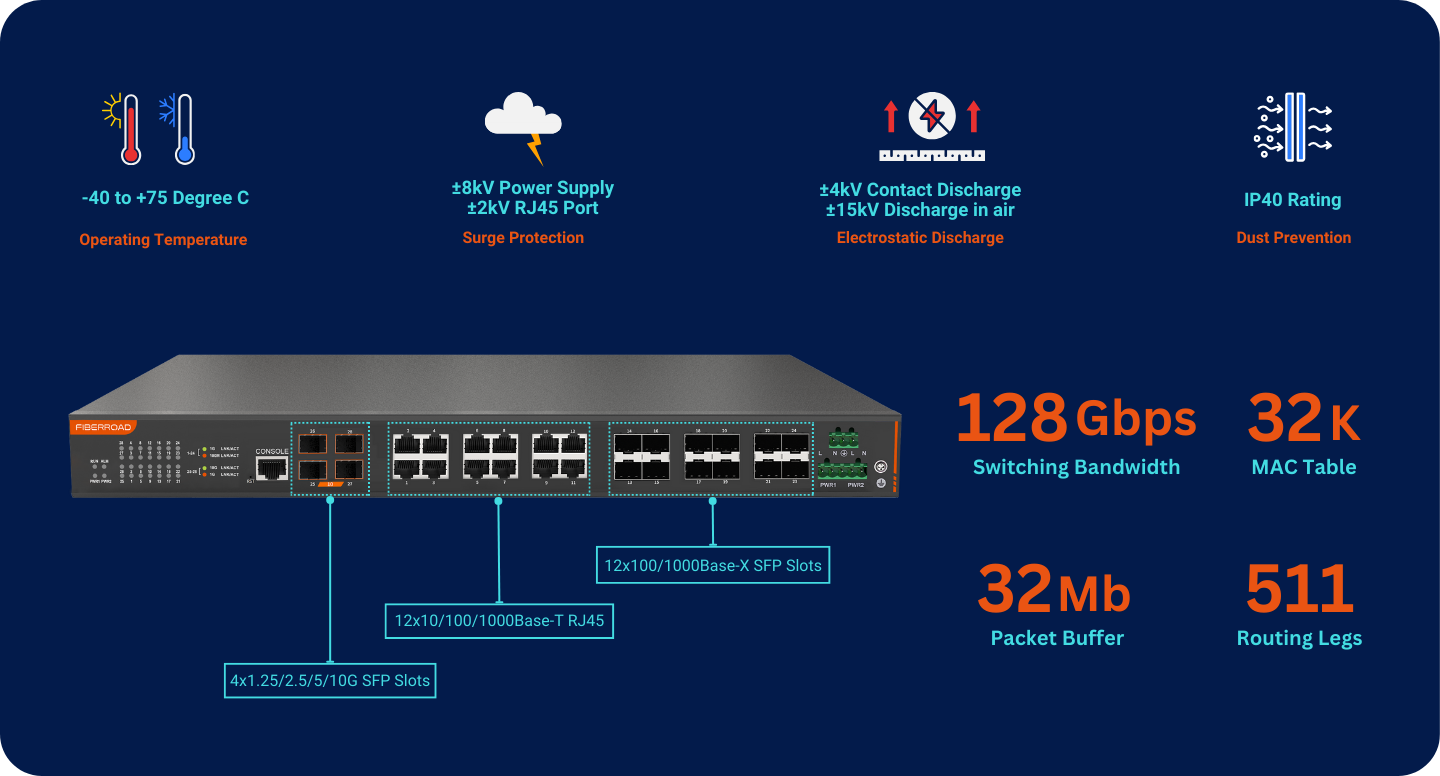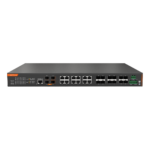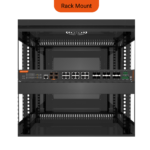Share This Product
Layer 3 TSN Switch Revolutionizes Industrial Operations with Seamless Connectivity
The Layer 3 TSN Switch is an indispensable tool for modern industrial operations seeking seamless connectivity and precise synchronization. Equipped with six-gigabit ports and two high-speed 2.5/10G SFP+ ports, data flows effortlessly at lightning speed, facilitating efficient communication between connected devices. Advanced IEEE time synchronization protocols such as 802.1 AS, 802.1Qbv, and 1588v2 guarantee that all devices are perfectly synced for real-time control applications. Additionally, features like layer 3 routing, unicast/multicast support, and seamless redundancy capabilities enhance network resilience while authentication via RADIUS and TACACS+ safeguards against unauthorized access. In essence, the Layer 3 TSN Switch offers the precision timing and unwavering uptime essential for today’s smart factories and industrial IoT networks – enabling businesses to achieve unparalleled network synchronicity digitally.

Top Features to Look for When Choosing a Layer 3 Ethernet Switch
The Layer 3 TSN Industrial Switch is a robust and versatile networking device designed to operate in extreme temperatures ranging from -40 to +75℃. With ±8kV Power Supply Surge Protection, this switch offers reliable performance even in harsh environments where power surges are common. Its impressive 128 Gbps Switching Bandwidth ensures fast and efficient data transfer rates, making it ideal for high-demand applications. Additionally, the switch features a generous 32Mb Packet Buffer, allowing for smooth and uninterrupted data flow without any delay or packet loss. Whether used in industrial settings or outdoor installations, the Layer 3 TSN Switch is a dependable solution for all your networking needs.

Layer 3 TSN Switch offers Seamless Protection Switching
TSN Ethernet Switch keeps your data flowing seamlessly by detecting failures in the network and automatically switching traffic to the backup link, then back again once the primary link is restored. Ideal for applications that cannot tolerate any disruption in transmissions like industrial automation, transportation systems and military networks that require continuous uptime. Fault protection done right, so your business can run at full speed ahead.
APS Protection
APS is a linear protection mechanism. With APS configured, a protection link is reserved for a working link. If a signal failure or degradation occurs on a working link, its traffic is switched to the protection link.
Media Redundancy Protocol
Media Redundancy Protocol (MRP) provides a recovery time of 10ms or less, fault tolerance, and load balancing. Ease of set-up and high-speed performance make Ring topology networks.
ERPS
Ethernet ring protection switching helps achieve high reliability and network stability. Links in the ring will never form loops that fatally affect the industrial network operation and service availability.



Monitor and Configure your Layer 3 TSN Switch via CLI, Web and SNMP
Take complete control of your network by utilizing the versatile Fiberroad TSN Switch. With console, web, and SNMP interfaces, this switch offers multiple methods for monitoring, configuring, and securing your network. The console interface grants direct access through CLI commands for advanced troubleshooting and configuration, while the web interface presents a user-friendly graphical dashboard. Additionally, SNMP support allows for seamless integration with network management systems and tools. These robust management features provide you with full visibility and command over network performance, allowing you to optimize uptime and productivity. As for security purposes, the switch employs various technologies to mitigate risks such as unauthorized access, data tampering, and system intrusions. Whether you are an IT professional or a network engineer, this adaptable switch delivers real-time network oversight and cybersecurity solutions to effectively manage and safeguard your network.
.png)
| Hardware Specifications | |
| Copper Port | 12×10/100/1000Base-T RJ45 auto-MDI/MDI-X
12×100/1000Base-X SFP Slots |
| SFP/SFP+ Port | 4×1/10G SFP/SFP+ slots
Compatible with 100BASE-FX,1000BASE-SX/LX/BX,2500BASE-X,5000BASE-X SFP and 10GBASE-SR/LR SFP+ optical transceiver |
| Console | 1xRJ45-to-RS232 serial port(115200,8,N,1) |
| Reset Button | <5 sec: System Reboot
> 5 sec: Factory Default |
| Connector | 6-pin removable terminal block for power input
Pin 1-2 for Power 1, Pin 3-4 for Power 2, Pin 5-6 for fault alarm |
| Alarm | One relay output for power failure. Alarm relay current carry ability: 2A @ 24VDC |
| Enclosure | IP40 aluminium case |
| Installation | DIN-rail or wall mounting |
| Dimension(WxDxH) | 400mm x 300mm x 45mm |
| Weight | 2.6kg |
| Power Consumption | Max. 16.8 watts/57.3BTU(System on)
MAX. 38.2 watts/10.3BTU(Full loading) |
| Electrostatic Discharge | Contact discharge:±8kV
Discharge in air: ±15kV |
| Surge Protection | Power Supply: ±4kV
RJ45 Port: ±2kV |
| LED Indicators | P1(Green), P2(Green), ALM(Red). RUN(Green)
SFP: 1/2.5/5G(Green), 10G(Green) RJ45: 10/100M(Green), 1000M(Green) |
| Switching Specifications | |
| Switch Architecture | Store-and-forward |
| Switch Fabric | 128 Gbps/non-blocking |
| Address Table | 32K entries, automatic sources address learning and aging |
| Data Buffer | 32Mbits |
| Jumbo Frame | 10K bytes |
| Flow Control | IEEE 802.3x pause frame for full duplex
Back pressure for half duplex |
| Layer 3 Function | |
| IP Interfaces | Max. 128 VLAN interface |
| Routing Table | Max. 512 static route entries
Max. 3072 routing table entries |
| Routing Protocol | IPv4 RIPv2
IPv4 OSPFv2 IPv6 OSPFv3 IPv4 Hardware Static Routing |
| Layer 2 Functions | |
| Port Configuration | Port Disable/Enable
Auto-negotiation 10/100/1000Mbps full and half duplex mode selection Flow control disable/enable Port link capability control |
| Port Status | Display each port’s speed duplex mode, link status, flow control status, auto-negotiation status, trunk status |
| Port Mirroring | TX/RX/Both
Many-to-1 monitor Mirror – Remote Switched Port Analyzer(Cisco RSPAN) Supports up to 5 sessions |
| VLAN | IEEE 802.1Q tagged VLAN
IEEE 802.1ad Q-in-Q tunneling Private VLAN MAC-based VLAN VLAN Translation VCL Protocol-based VLAN Voice VLAN MVR(Multicast VLAN registration), MVRP(Multiple VLAN Registration Protocol GVRP Up to 4K VLAN groups, out of 4095 VLAN IDs |
| Link Aggregation | IEEE 802.3ad LACP/static trunk
8 trunk groups with 16 ports per trunk group |
| Spanning Tree Protocol | IEEE 802.1D Spanning Tree Protocol
IEEE 802.1w Rapid Spanning Tree Protocol IEEE 802.1s Multiple Spanning Tree Protocol Supports 7 MSTP instance BPDU Guard, BPDU filtering and BPDU transparent Root Guard |
| IGMP Snooping | IPv4 IGMP(v1/v2/v3) snooping
IPv4 IGMP querier mode support Supports 255 IGMP groups |
| MLD Snooping | IPv6 MLD(v1/v2) snooping
IPv6 querier mode support Support 255 MLD groups |
| Bandwidth Control | Per port bandwidth control
Ingress: 10Kbps ~ 13128Mbps Egress: 10Kbps ~ 13128Mbps |
| Ring, Redundancy, Protection | APS Protocol (1+1 , 1:1 Mode)
MRP(Media Redundancy Protocol) ITU-T G.8032 ERPSv2 Recovery time<10ms @ 3 nodes Recovery time<50ms @ 16 node Supports Major and sub-ring |
| Discovery and Monitoring | UPnP(Universal Plug and Play)
LLDP LLDP-MED UDLD(Unidirectional Link Detection) sFLOW |
| OAM | IEEE 802.3ah OAM,
IEEE 802.1ag Connectivity Fault Management(CFM) |
| Synchronization | IEEE 1588v2 PTP(Precision Time Protocol)
PTP Master PTP Slave Boundary Clock Peer-to-peer transparent clock End-to-end transparent clock Profile:1588/G.8265.1/G.8275.1/802.1AS |
| QoS | Traffic classification based, strict priority and WRR
8-level priority for switching -Port number -802.1p priority -802.1Q VLAN tag -DSCP/ToS field in IP packet |
| Time-Sensitive Networking Protocols | High Precision Time Synchronization
-IEEE1588(Time Stamping) -802.1AS-Rev gPTP default profile |














